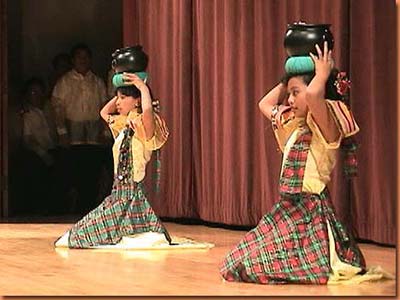Filipino Folk Dance And Its Music
Pandanggo sa Ilaw
MP3 file (pandanggo.mp3 - 1.54MB)
MIDI file (pandango.mid)
(pahn-DAHNG-go-sah-EEH-lawh)
This popular dance of grace and balance comes from Lubang Island, Mindoro in the Visayas region. The term pandanggo comes from the Spanish word fandango, which is a dance characterized by lively steps and clapping that varies in rhythm in 3/4 time. This particular pandanggo involves the presence of three tinggoy, or oil lamps, balanced on the head and the back of each hand.
Maglalatik
MP3 file (maglalatik.mp3 - 1.74MB)
MIDI File (maglalat.mid)
(mahg-lah-lah-TIHK)
During the Spanish regime, the present barrios of Loma and Zapote of Binan, Laguna, were separated. With coconut shells as implements the people of these two barrios danced the Maglalatik, or Magbabao, a war dance depicting a fight between the Moros and the Christians over the latik (residue left after the coconut milk has been boiled). The first two parts of the dance, the Palipasan and the Baligtaran show the heated encounter between the two groups. The last two parts, the Paseo and the Sayaw Escaramusa show the reconciliation between the two groups. According to the legend the Moros came out victorious, thus getting the coveted latik. The Christians, not contented with the result of the war, sent an envoy to the Moros to offer peace and to baptize them.)
Itik-itik
Audio sample (itikitik.wav)
(EEH-tihk-EEH-tihk)
At one baptismal party in the Surigao del Norte province, a young lady named Kanang (the nickname for Cayetana), considered the best dancer and singer of her time, was asked to dance the Sibay. She became so enthusiastic and spirited during the performance that she began to improvise movements and steps similar to the movements of itik, the duck, as it walks with short, choppy steps and splashes water on its back while calling to its mate. The people liked the dance so much that they all imitated her. There are six separate foot sequences in the series of Itik-Itik steps.
Tinikling
MP3 file![]()
Enhanced MIDI File (tinik2.mid)
Original MIDI File (tiniklng.mid)
(tih-NIHK-lihng)
Honored as the Philippine national dance, Tinikling is a favorite in the Visayan islands, especially on the island of Leyte. Dancers imitate the tikling bird’s legendary grace and speed as they skillfully play, chase each other, run over tree branches, or dodge bamboo traps set by rice farmers. Hence it is named after the bird, tikling. this version of the dance is done between a pair of bamboo poles. The older people claim that the ‘Tinikling Ha Bayo’ from which the tinikling dance evolved is more difficult to perform. It was originally danced between ‘bayuhan’, two wooden pestles used to pound the husks off the rice grain.
Carinosa
MIDI File (carinosa.mid)
(kah-reehn-YOH-sah)
Habanera Botolena
It originated from Botolan, Zambales. This dance is a combination of Spanish and Philippine steps with flamenco influence. This is a social popular dance in the North among the Ilocanos. It is a courtship dance but sometime it is also performed during weddings and other social gatherings.
Singkil
(seehng-KEEHL)
MIDI File (singkil.mid)
This dance takes its name from the bells worn on the ankles of the Muslim princess. Perhaps one of the oldest of truly Filipino dances, the Singkil recounts the epic legend of the "Darangan" of the Maranao people of Mindanao. This epic, written sometime in the 14th century, tells the fateful story of Princess Gandingan, who was caught in the middle of a forest during an earthquake caused by the diwatas, or fairies of the forest. The criscrossed bamboo poles represent the trees that were falling, which she gracefully avoids. Her slave loyally accompanies her throughout her ordeal. Finally, she is saved by the prince. Dancers skillfully manipulate apir, or fans which represent the winds that prove to be auspicious. Royal princesses to this day in the Sulu Archipelago are required to learn this most difficult and noble dance.
There are other versions of Singkil. Perhaps the version more widely performed by dance companies is the "Garden Singkil." The story goes that the princess goes into her garden, accompanied by her slave, and plays with the butterflies, which are represented by the fan dancers. The movements of the fans supposedly represent those of the butterflies, as opposed to the diwatas. In another popular version, the prince uses a scarf instead of a sword.
Binasuan
Subli
Photos of the Bayanihan Cultural Organization Dance Troupe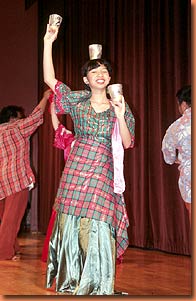
Pandango Sa Ilaw.
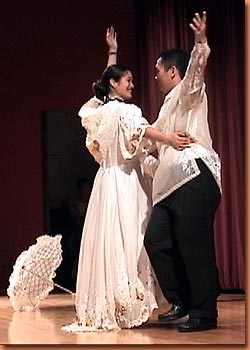
Habanera Botolena.
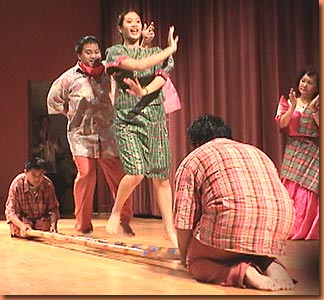
Tinikling.
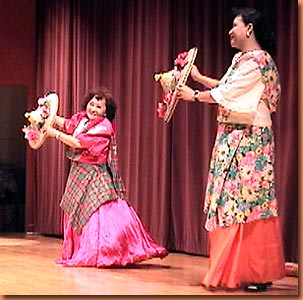
Salakot.
